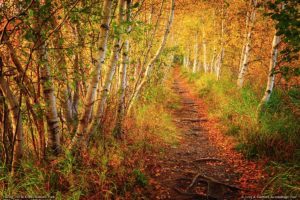White Birch Tree
Walks in the woods on a warm, sunny, fall days are one of my favorite experiences. If the trail winds through trees that include white birch, it transforms into the mystical realm. No words, photographs, video or other forms of art can capture the human perception using all your senses. The aroma of dry leaves, mixed with the caress of a soft fall breeze on your skin, the faint sounds reaching your ears of falling leaves landing on the forest floor. All those wonders are background to the visual deluge of a pallet of radiant oranges, yellows, reds, greens accentuated by the glowing white bark of the white birch. Those days remain burned in your brain for a lifetime. It approaches falling in love without the stormy ecstasy of it, but like love, impossible to describe. The closest I can get with words is “serene rapture.”
 Photo by Greg A. Hartford
Photo by Greg A. HartfordPhoto From Greg A. Hartford’s AcadiaMagic website
During the last Ice Age, a vast White Spruce forest covered the Great Plains and eastern United States just south of the tundra bordering the great ice sheets. The White Birch, along with the spruce were some of the earliest species to follow the retreating ice sheets northward, reaching the Canadian border soon after the ice retreated.
The White Birch is a small to medium sized deciduous tree, which usually grows to approximately 70 feet in height, although some at 130 feet are known. The average life expectancy is about 60 to 70 years, which is short for trees. It is recognized by its bark, which is bright white, and smooth with small black marks and scars. It often separates into papery strips and is easily peeled off in sheets. It is native to North America, from Alaska, throughout Canada, and as far south as North Carolina.
Other Common Names are Canoe Birch, Paper Birch, and Silver Birch
New Hampshire state tree
Saskatchewan provincial tree
Sap can be boiled down to produce birch syrup, and also can be used for wine, beer, and medicinal tonics
Wood makes excellent high-yielding fire wood, lumber for furniture, flooring, and popsicle sticks
Native Americans used White Birch bark to cover canoes, make baskets, baby carriers, mats, torches and moose calls. The wood was strong and flexible so they used it to fashion spears, bows and arrows, snowshoes, and sleds.
Although moose and white-tailed deer will eat the leaves and tender shoots of the White Birch, it is not their favorite food. Porcupines like to eat the bark and rabbits eat the seedlings and young saplings. Beavers also eat it although generally prefer aspen, while willow and White Birch are second choices. Yellow-bellied sapsuckers will peck little holes in the bark and feed on the sap. Hummingbirds and squirrels also drink the sap from the sap wells made by the sapsuckers.
The post White Birch Tree appeared first on R. A. Andrade.



